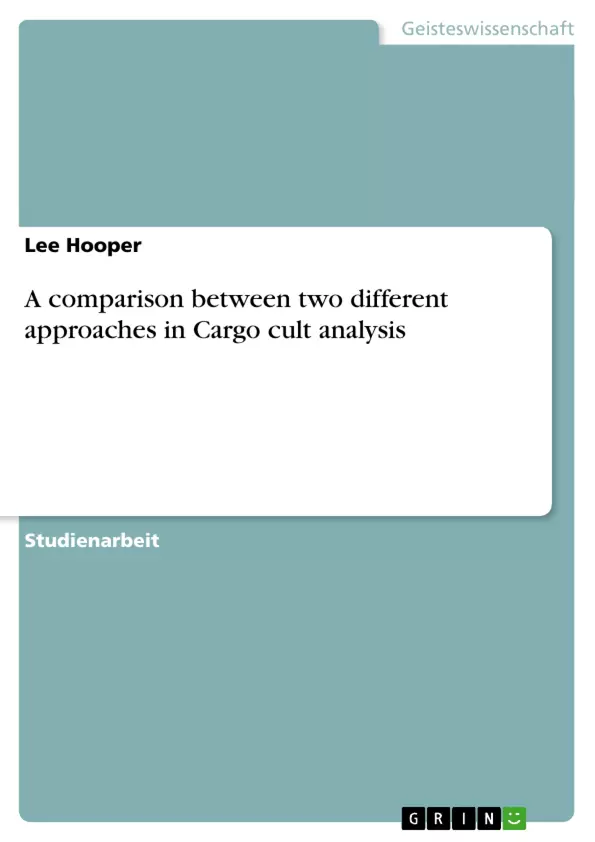Since their appearance and documentation in the South Pacific, anthropologists have found it difficult to agree on how to define cargo cults. This is due to the ambiguity of whether the practice constitutes a deviation from normal social relations and the implicit derogative nature of the word cult. By first outlining a description of what cargo cults are and how they have been classically interpreted, a comparison will be made between the theories of Leavitt (2000) and McDowell (2000), two theorists that have diverged from the classic writings on the topic. Through explaining both theorists work and comparing them, it will be concluded that a dualistic approach is necessary in gaining the most complete analysis of the cargo phenomenon and that substituting the term cargo cult with cargoism allows for a more objective approach in analysing this practice.
Since their appearance and documentation in the South Pacific, anthropologists have found it difficult to agree on how to define cargo cults. This is due to the ambiguity of whether the practice constitutes a deviation from normal social relations and the implicit derogative nature of the word cult . By first outlining a description of what cargo cults are and how they have been classically interpreted, a comparison will be made between the theories of Leavitt (2000) and McDowell (2000), two theorists that have diverged from the classic writings on the topic. Through explaining both theorists work and comparing them, it will be concluded that a dualistic approach is necessary in gaining the most complete analysis of the cargo phenomenon and that substituting the term cargo cult with cargoism allows for a more objective approach in analysing this practice.
Cargoism is a phenomenon that occurs in some pre-industrial societies, primarily in South Pacific areas such as Melanesia and Micronesia (Lindstrom, 1996, pp. 128-130). It involve the ritualistic practice of cargo acquisition through magic and religious practices and view Europeans, who brought this cargo to their islands, as having a significant role in this acquisition. The cargo is usually in the form of manufactured goods, such as those which are more technologically advanced than their own, and the relationship to the Europeans typically consists of perceiving them as the embodiment of dead relatives who have direct influence and power over the direction of where the cargo is placed.
Indigenous peoples believe that this cargo is destined, by divine right of their deceased ancestors, to be theirs (Goodale & Chowning, 1996, p.71; Lindstrom, 1996, pp. 128-130). However the Europeans have manipulated this transaction somehow and must be coerced into giving it to them. In response to this unfair control of resources, indirect rituals such as the re-enactment of observed behaviour in those who held these resources were conducted, alongside direct personal interaction with a European, to find out their secrets of this acquisition.
The cargoist movement increased with the influx of military cargo during and immediately after World War II, and gained popularity among sociologist and anthropologists - particularly when cargo cessed to arrive and the indigenous population began a heightened increase in ritualistic practices (Lindstrom, 1996, pp. 128-130).
The term “cargo cult” was conceived by the anthropologist Lamont Lindstrom in 1945, and alongside the pioneering work of Kenelm Burridge and Peter Worsley, replaced the then Western perception that cargoist rituals were a symptom of psychological madness (Holger, 2004, p.1; Kaplan, 1995, pp. xi-xii). Each theorist had their own analysis on the reasons why this practice existed. Burridge argued that cargo cults represented “myth dreams” and functioned as a tool for social and psychological (moral) regeneration, with prominent ‘cult’ leaders functioning as symbolic movements within society (Burridge, 1960, pp.246-248).
Worsley, in contrast, believed that the behaviour could be understood within a political and economical context and the cargo practice was in fact an elemental part of forming “proto-nationalist” identity groups (Worsley, 1957, pp. 254-255). These groups functioned to bring stability and give some sort of political power back to the people in a quasi-nationalist form. Both theorists, whilst determining different factors of importance in the development of cargo cults, believed in their actual existence as something that was deviating from ‘normal’ behaviour (Kaplan, 1995, pp. xi-xii).
Lindstrom placed the cargoist activities in relation to Western desires, such as the desire for love, and imagination (Otto, 2010, p.88). He viewed the desire for cargo in the South Pacific as an extended projection of a central Western cultural theme – namely the constant longing of ‘things’ to fulfil oneself. This desire is then played out through imagination in another cultural setting, which happens to be the Melanesian one in this case. Lindstrom’s theory differs from Burridge’s and Worsley’s theories as it brings into question whether cargoism exists outside of the Western (anthropological) mind has become a generalised interpretation of Melanesian culture. For example, Lindstrom frequently compared cargoism to Millenarian movements, such as the Christian rapture over the coming of Jesus Christ.
[...]
- Arbeit zitieren
- Lee Hooper (Autor:in), 2011, A comparison between two different approaches in Cargo cult analysis, München, GRIN Verlag, https://www.grin.com/document/233134



